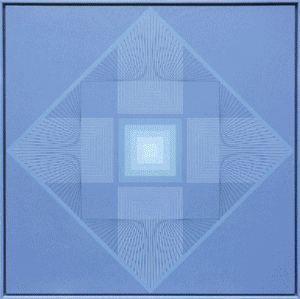- Transmission Difficulties
- Vancouver Painting in the 1960s
- A painting is a pitiable thing . . .
- The experience of a work of art . . .
- A painting is mediumistic . . .
- By Scott Watson
11.
In Kiyooka's absence, the most watched of the young hard-edge painters in the city were Bodo Pfeifer and Brian Fisher. Pfeifer had studied in Montréal and his native Germany before studying at the Vancouver School of Art with Roy Kiyooka and Jack Shadbolt. By the time of Canada 101, an exhibition of Canadian art held at the Edinburgh International Festival in 1968, the Musée des Beaux Arts had purchased one of his paintings.17
Pfeifer's ideas, as reported in Vancouver Life on the eve of his 1967 exhibition at the Douglas Gallery, included the disposability of art - a widespread notion that was the ironic embrace of the increasing commodification of art. "I am opposed to the idea of precious paintings. Art should be lived with. Only a few pieces will survive the ages, even though they may be quite exciting when they are new. Let's just keep the best pieces for reference and chuck the rest."18 Within ten years of stating this, Pfeifer himself turned his back on painting in favour of gardening. His hard-edge paintings, celebrated at the time, have made appearances in recent exhibitions about the sixties, but less is known of his other ideas, such as paintings consisting of optional modules, a notion taken up by B.C. Binning in 1970. Most remarkably, as Pfeifer's painting vocabulary became more "minimal," his notions of painting headed toward the psychedelic sensorium: "He would like," Eileen Johnson concluded, "to build a computer that would change sounds to colours, then to confound the senses with a symphony in full colour."19 Toward that goal he began to produce sculpture incorporating light. This other drive, toward art as sensorial environment, art as life, art as communication, animated every painter of the sixties. The contradiction between this tendency and the high-art position that held painting, especially abstract painting, as autonomous and non-referential, inhabited most artistic practices of the day. Pfeifer, for example, on the one hand a proponent of ephemerality, integration into the environment and electronic media, could still be convinced that a painting, especially an abstract painting, was a self-sufficient creation requiring no interpretation or understanding: "Most Vancouver painters tickle the brain rather than the eye but my paintings are purely visual. Any literary association takes away from the concept of the painting."
Another Regina-Vancouver School of Art-Kiyooka-schooled hard-edge painter . . .
In Kiyooka's absence, the most watched of the young hard-edge painters in the city were Bodo Pfeifer and Brian Fisher. Pfeifer had studied in Montréal and his native Germany before studying at the Vancouver School of Art with Roy Kiyooka and Jack Shadbolt. By the time of Canada 101, an exhibition of Canadian art held at the Edinburgh International Festival in 1968, the Musée des Beaux Arts had purchased one of his paintings.17
Pfeifer's ideas, as reported in Vancouver Life on the eve of his 1967 exhibition at the Douglas Gallery, included the disposability of art - a widespread notion that was the ironic embrace of the increasing commodification of art. "I am opposed to the idea of precious paintings. Art should be lived with. Only a few pieces will survive the ages, even though they may be quite exciting when they are new. Let's just keep the best pieces for reference and chuck the rest."18 Within ten years of stating this, Pfeifer himself turned his back on painting in favour of gardening. His hard-edge paintings, celebrated at the time, have made appearances in recent exhibitions about the sixties, but less is known of his other ideas, such as paintings consisting of optional modules, a notion taken up by B.C. Binning in 1970. Most remarkably, as Pfeifer's painting vocabulary became more "minimal," his notions of painting headed toward the psychedelic sensorium: "He would like," Eileen Johnson concluded, "to build a computer that would change sounds to colours, then to confound the senses with a symphony in full colour."19 Toward that goal he began to produce sculpture incorporating light. This other drive, toward art as sensorial environment, art as life, art as communication, animated every painter of the sixties. The contradiction between this tendency and the high-art position that held painting, especially abstract painting, as autonomous and non-referential, inhabited most artistic practices of the day. Pfeifer, for example, on the one hand a proponent of ephemerality, integration into the environment and electronic media, could still be convinced that a painting, especially an abstract painting, was a self-sufficient creation requiring no interpretation or understanding: "Most Vancouver painters tickle the brain rather than the eye but my paintings are purely visual. Any literary association takes away from the concept of the painting."
Another Regina-Vancouver School of Art-Kiyooka-schooled hard-edge painter . . .

